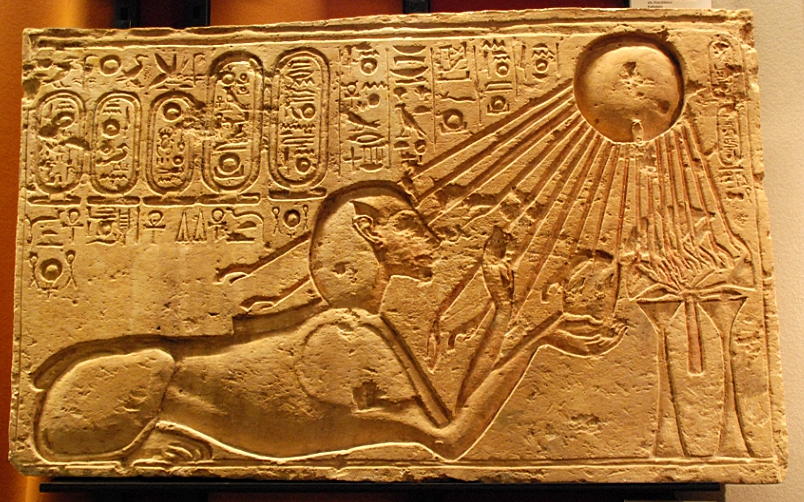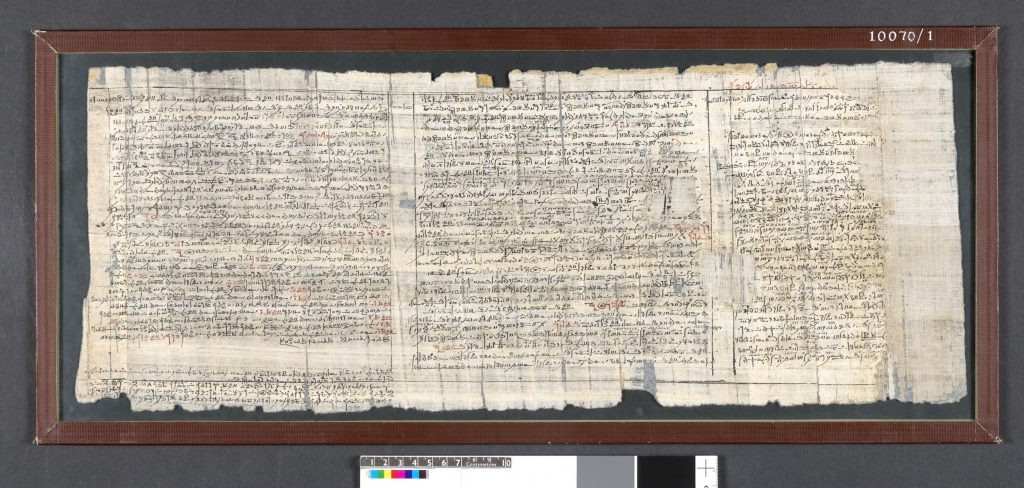This post is the third in a mini-series about bilingual recipes in Egyptian and Greek from the 3rd/4th century papyrus codex PGM IV (Greek Magical Papyrus 4) – the “Bilingual Solar Divination through Boy Medium” (PGM IV. 88-93). This practice, inscribed upon page 5 of the codex, is paralleled among Demotic examples of divinations using boy mediums but here is attested in a bilingual Greek and Old Coptic text. Through bringing about the manifestation of a deity, the practitioner could ask the boy to ask the deity about anything that they wished to know.

Although a relatively short recipe compared to those we have looked at earlier, the series of ritual instructions in Greek and invocations in Egyptian evidence a rarely attested, and thus little studied, practice of divination. This recipe is unusual, firstly because the invoked deity is supposed to manifest in the light or the disk of the sun, and secondly because divine interaction occurs through a boy medium. Unlike in the previous examples, where the practitioner himself is either supposed to have a face-to-face encounter with the manifest deity, in this example the practitioner must employ a boy to act as the medium who will interact with the deity.
Titled “to the sun”, the ritual instructions in Greek tell the practitioner to dress a boy in linen from head to toe – comparable to the dress and therefore ritual purity of priests in Egyptian temples. The practitioner must then stand the boy facing the sun. While standing behind him, a formula must be recited.
“I am Bar Bariōth Bar Bariōth;
I am Peskout, namely: Iaho, Adōnai, Elōai, and Sabaōth.
Come into this little-one today, because it is I, Bar Bariōth.”

This formula begins with statements in which the practitioner identifies with a deity in order to utilise their power. The practitioner first claims to be a deity named Bar Bariōth, twice, and Peskout once. Invocations follow, to the Jewish-Christian(?) Iao, Adonai, Elohim, and Sabaoth. This tetrad is often found in the Graeco-Egyptian Magical Papyri as a means through which the invoke Yahweh, the Hebrew God. Iao is the tetragrammaton – the four-letter name of Yahweh; Adonai is the Hebrew word for “Lord” as a name of God; Elohim is the Hebrew plural of “God”, used as another name for Yahweh; and Sabaoth is another of his names, meaning “(Lord) of Hosts”. Then come the commands, in which the practitioner instructs the deity to manifest before the boy, presumably through or in the medium of the sun’s disk or its light, which the boy is to face.
Although invoking no traditional Egyptian deities, it is notable that the closest parallels are preserved in Demotic magical texts, that is, in the Egyptian-language tradition. In the Demotic magical papyrus of London-Leiden (PDM xiv. 856-875; 875-885), an “inquiry of the sun” is given in two versions, providing the only direct parallel to the bilingual example considered here. In those examples, the deities are described as appearing to the boy, and the text states that the boy medium will tell the practitioner an answer to everything about which he will ask – clarifying the mechanics through which the practitioner acquires foreknowledge.

These parallels suggest that this bilingual recipe follows a tradition of magical practices only otherwise attested in monolingual recipes in Demotic among the Egyptian-language tradition of magical texts. It is, however, not traditional Egyptian deities which are invoked as the agents through which the foreknowledge can be acquired, but the aforementioned tetrad of Iao, Adonai, Elohim, and Sabaoth. Traditional Egyptian deities are also not the source of the practitioner’s power, for he identifies himself with Bar Bariōth, a name which likely has Hebrew origins. This bilingual composite recipe is therefore evidence of bilingual practitioners who had fully adopted a host of deities into their pantheon with whom they could identify, and whom they could command to provide them with the foreknowledge they sought. They also evidence the efficacy of invocations in the Egyptian language, as opposed to in Greek, even though the Egyptian language does not contain the millennia-old deities of Egyptian tradition – unlike the first example in this mini-series.
The next two posts in this mini-series will consider the remaining two bilingual recipes in this codex. The first is a composite of erotic recipes, which draw almost exclusively from Egyptian tradition, while the second is a composite of exorcistic recipes, which stem exclusively from outside Pharaonic tradition. Alongside the three bilingual divinations considered so far in this mini-series, the further two will continue to highlight that even in just a few pages of this extraordinary codex, and among a few recipes without many parallels, a diversity of practices are preserved that at once invoke a host of traditional and syncretic deities within long-established and novel ritual mechanics – attesting to the melting pot of 3rd/4th century CE Egypt.
Bibliography and Further Reading
For the most recent study of this recipe, see section §4.3 in Chapter 4 of Love, Edward O. D. Code-Switching with the Gods: The Bilingual (Old Coptic-Greek) Spells of PGM IV (P. Bibliothèque nationale supplement Grec. 574) and their Linguistic, Religious, and Socio-cultural Context in Late Roman Egypt. Berlin: De Gruyter, 2016. URL
